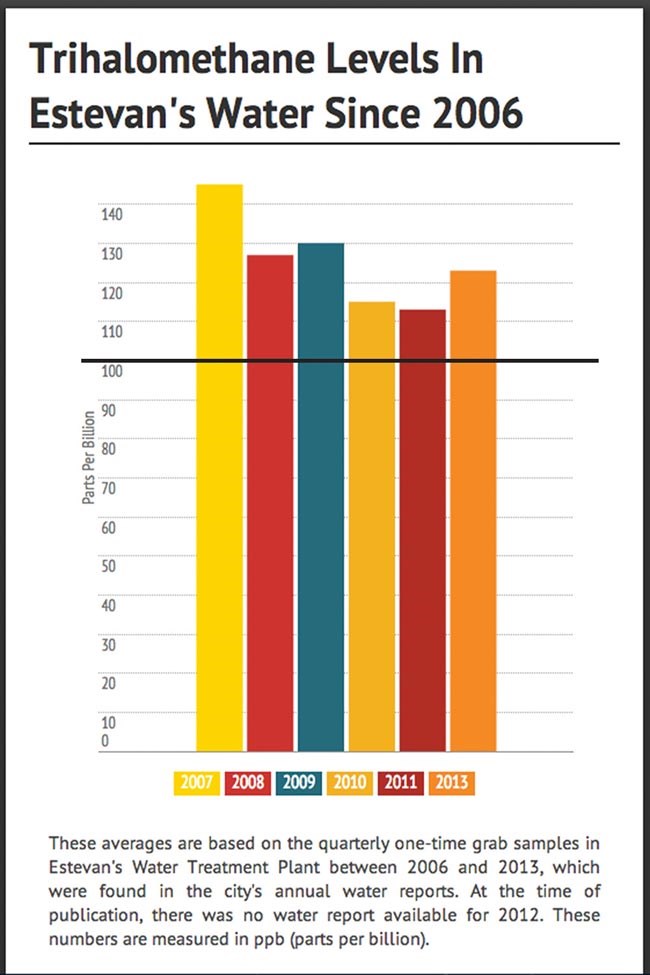Despite Estevan's ability to lower its higher than normal trihalomethane (THM) levels in the city's water, the bigger problem has reared its head as municipalities across Saskatchewan try to manage THMs in their own surface water supplies.
According to saskh20.com, the Government of Saskatchewan's website that relates to its water, over 100 municipalities had elevated THM levels in their drinking water in 2008 and Estevan has found itself in that category for many years now. Since 2006, Estevan's annual THM levels have been above acceptable levels but have gradually decreased and were at their lowest levels in 2011, according to the City's annual water reports.
A combination of four different chemicals, THMs emerge as a result of a chemical reaction between the chlorine used in our water's disinfection process, and the natural organic matter found in the water itself. The maximum acceptable concentration for THMs in drinking water for Canada is 100 ppb (parts per billion).
"Here in Saskatchewan, we definitely have a lot of water challenges, especially with surface waters," said Helen Baulch, an assistant professor from the Global Institute of Water at the University of Saskatchewan.
She said that bodies of water in Saskatchewan, particularly surface waters, are rich in dissolved organic carbons, which increase the chances of THMs being formed throughout the filtration process.
These pieces of organic matter can range from flooded vegetation, to an annual transfer from another water body that enters the surface water we draw from, said Dr. Lalita Bharadwaj, an associate professor from the School of Public Health at the U of S.
Bharadwaj said assessment studies involving human exposure to THMs have been minimal, but animal testing has shown a possible link to cancer.
"Right now, Health Canada has deemed THMs as a possible carcinogen based on evidence in animal studies, but there's inconclusive evidence in human studies," she said.
Kevin Sutter, manager at the Estevan Water Treatment Plant, stressed the point that despite the negative health effects that potentially arise as a result of continuous exposure to THMs, compromization of the filtration process is not an option.
"Water borne illnesses are far more hazardous than the higher THM levels," he said. "Over the past several years, we have lowered (THM levels) considerably, and we're doing everything we can to get them under minimum levels."
Sutter added the City has implemented a variety of water treatment methods over the past decade to combat THMs.
He said Estevan has limited the amount of time and the amount of chlorine the water is exposed to, while still meeting disinfection requirements. They've also implemented ultra violet light to the disinfection process so that less chlorine is needed, and even added ammonia to the water, a special compound that attaches itself to chlorine, so the water stops forming more THM's in the distribution system.
Alternate water sources, with lower levels of organic matter, have also been considered, said Sutter.
The Rafferty Dam Reservoir has been on Estevan's radar for several years. This body of water contains less organic carbons and dissolved minerals, and would therefore be easier to treat compared to Estevan's current water source, the Boundary Dam Reservoir, Sutter explained.
Estevan Mayor Roy Ludwig said a study commissioned by the City to analyze the alternate water source has been ongoing for several years.
"Our long term plan is to switch to Rafferty, absolutely," he said.
Baulch said looking for alternate water sources is a step in the right direction when it comes to trying to minimize THM levels, but with so many smaller water utilities across the province, those smaller pockets of municipalities may find it challenging to combat THMs.
"The THM problem isn't unique to Saskatchewan, but is evident across the country, and particularly small water supplies that don't necessarily have the technology in place to deal with some of the THM issues," she said.
Dr. Shauna Hudson, Medical Health Officer for the Sun Country Health Region, said people should feel safe drinking their water, but if they want to take extra precautions, certain steps can be taken at home to minimize overall exposure to THMs, which can be absorbed through the skin through regular consumption.
"People can take shorter showers and baths, or purchase home water treatment systems that meet Canadian NSF (National Sanitation Foundation) standards," she said.




